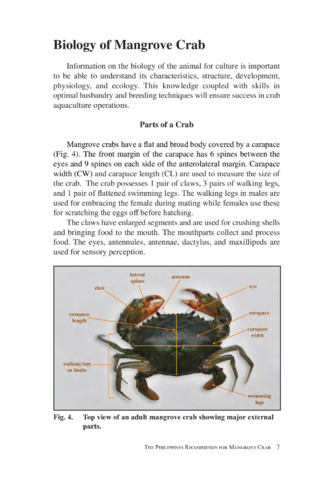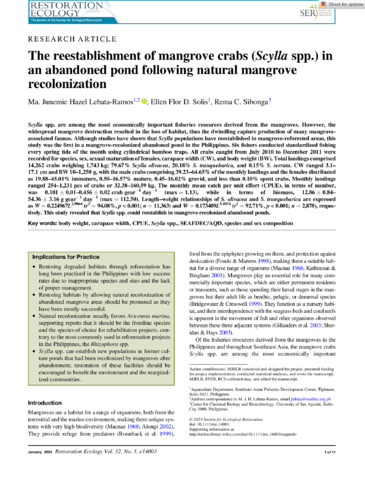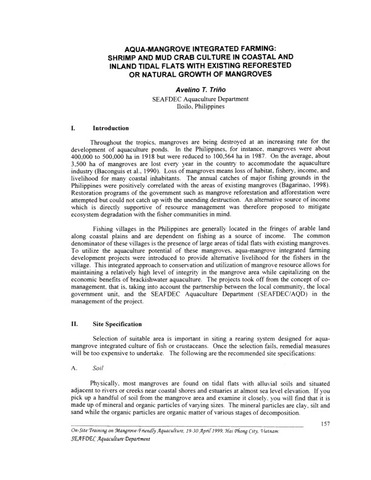Mud crab (Scylla serrata) culture in tidal flats with existing mangroves
| dc.contributor.author | Triño, Avelino T. | |
| dc.contributor.author | Rodriguez, Eduard M. | |
| dc.contributor.editor | Primavera, Jurgenne H. | |
| dc.contributor.editor | Garcia, Luis Ma. B. | |
| dc.contributor.editor | Castaños, Milagros T. | |
| dc.contributor.editor | Surtida, Marilyn B. | |
| dc.date.accessioned | 2011-06-22T09:35:53Z | |
| dc.date.available | 2011-06-22T09:35:53Z | |
| dc.date.issued | 2000 | |
| dc.identifier.citation | Triño, A. T., & Rodriguez, E. M. (2000). Mud crab (Scylla serrata) culture in tidal flats with existing mangroves. In J. H. Primavera, L. M. B. Garcia, M. T. Castaños, & M. B. Surtida (Eds.), Mangrove-Friendly Aquaculture: Proceedings of the Workshop on Mangrove-Friendly Aquaculture organized by the SEAFDEC Aquaculture Department, January 11-15, 1999, Iloilo City, Philippines (pp. 171-176). Tigbauan, Iloilo, Philippines: Aquaculture Department, Southeast Asian Fisheries Development Center. | en |
| dc.identifier.isbn | 9718511423 | |
| dc.identifier.uri | http://hdl.handle.net/10862/454 | |
| dc.description.abstract | The performance of the mud crab Scylla serrata (Forsskal) in 200 m2 pens installed in tidal flats with existing mangroves was determined in a factorial experiment with stocking density (0.5 or 1.5/m2) and feed (salted fish by-catch or a mixed diet of 75% salted brown mussel flesh and 25% salted fish by-catch) as main factors. Duration of the experiment was 160 days. Results showed no interaction between feed and stocking density so data were pooled for each feed and stocking density treatment. There was no significant differences in growth, feed conversion ratio (FCR), survival, and production among two types of feed. Regardless of feed, the FCR was significantly more efficient and survival significantly higher at 0.5 than at 1.5/m2 stocking density. Growth, however, was not significantly different. Cost-return analysis on a per crop/200 m2 basis showed that the use of either of the two stocking density levels with either of the two types of feed was economically viable with a return on capital investment of 65-87%. Partial budgeting analysis, however, revealed that net earnings were increased by P1,128.00 if crabs were stocked at 1.5/m2 and P881.00 if fed a mixed diet of 75% salted brown mussel flesh and 25% salted fish by-catch compared with crabs stocked at 0.5/m2 and fed salted fish by-catch alone. | en |
| dc.language.iso | en | en |
| dc.publisher | Aquaculture Department, Southeast Asian Fisheries Development Center | en |
| dc.subject | crabs | en |
| dc.subject | Philippines | en |
| dc.subject | Scylla serrata | en |
| dc.subject.lcc | VF SP 258 | |
| dc.title | Mud crab (Scylla serrata) culture in tidal flats with existing mangroves | en |
| dc.type | Conference paper | en |
| dc.citation.spage | 171 | |
| dc.citation.epage | 176 | |
| dc.citation.conferenceTitle | Mangrove-Friendly Aquaculture : Proceedings of the Workshop on Mangrove-Friendly Aquaculture organized by the SEAFDEC Aquaculture Department, January 11-15, 1999, Iloilo City, Philippines | en |
| dc.subject.asfa | cage culture | en |
| dc.subject.asfa | crab culture | en |
| dc.subject.asfa | economic analysis | en |
| dc.subject.asfa | mangrove swamps | en |
| dc.subject.asfa | mangroves | en |
| dc.subject.scientificName | Scylla serrata | en |
Files in this item
This item appears in the following Collection(s)
-
Mangrove Friendly Aquaculture [18]
Proceedings of the Workshop on Mangrove-Friendly Aquaculture organized by the SEAFDEC Aquaculture Department, January 11-15, 1999, Iloilo City, Philippines






